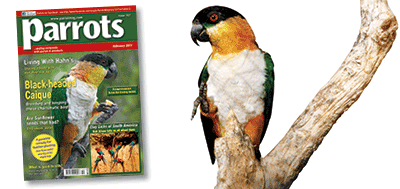
Buy your copy now!
Save money if you subscribe - 12 issues for the price of 11
In this issue...
- Sunflower Seeds - my views - read more
- What is Good Health? - read more
- Living with a pair of vivacious Hahn's Macaws - read more
- The Black-headed Caique - read more
- Clay Licks of South America - read more
- News, Bird Alert, Readers Story, FREE classified advertising and a full listing of Avian Vets
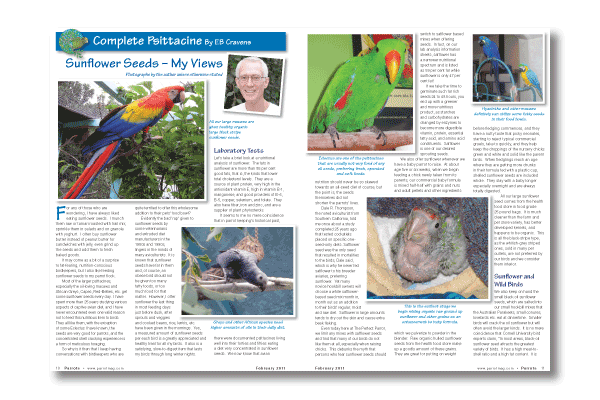
Sunflower Seeds – My Views
For any of those who are wondering, I have always liked eating sunflower seeds. I munch them raw or tamari roasted with trail mix, sprinkle them in salads and on granola with yoghurt. I often buy sunflower butter instead of peanut butter for sandwiches with jelly, even grind up the seeds and add them to fresh baked goods.
It may come as a bit of a surprise to fat-fearing, nutrition-conscious birdkeepers, but I also like feeding sunflower seeds to my parrot flock. Most of the larger psittacines, especially the oil-loving macaws and African Greys, Capes, Red-Bellies, etc. get some sunflower seeds every day. I have spent more than 25 years studying various aspects of captive avian diet, and I have never encountered even one valid reason not to feed this nutritious item to birds. They all like them, with the exception of some Eclectus I have known, the seeds are very good for parrots, and the concentrated shell cracking experience is a form of meticulous foraging.
Read more in the magazine…
Buy a copy now!
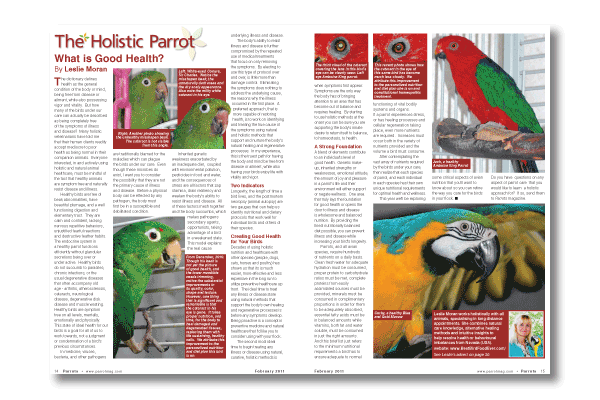
What is Good Health?
The dictionary defines health as the general condition of the body or mind, being free from disease or ailment, while also possessing vigor and vitality. But how many of the birds under our care can actually be described as being completely free of the symptoms of illness and disease? Many holistic veterinarians have told me that their human clients readily accept mediocre to poor health as being normal in their companion animals. Everyone interested, in and actively using holistic and natural animal healthcare, must be mindful of the fact that healthy animals are symptom free and naturally resist disease and illness.
Healthy birds are free of beak abnormalities, have beautiful plumage, and a well functioning digestion and elementary tract. They are calm and confident, lacking nervous repetitive behaviors, unjustified fearful reactions and destructive feather habits. The endocrine system in a healthy parrot functions efficiently without glandular secretions being over or under active. Healthy birds do not succumb to parasites, chronic infections, or the usual degenerative diseases that often accompany old age - arthritis, atherosclerosis, cataracts, neurological disease, degenerative disk disease and muscle wasting. Healthy birds are symptom free on all levels, mentally, emotionally and physically. This state of ideal health for our birds is a goal for all of us to work towards, not a judgment or condemnation of a bird’s previous circumstances.
Read more in the magazine…
Buy a copy now!

When Joan Lynch from Berkshire brought home a pair of caged and untamed Hahn’s Macaws, that had fallen victim to a broken marriage, she knew absolutely nothing about parrots, and had no idea what she was taking on, but that didn’t faze her for one moment. Her husband wasn’t altogether surprised either, as over the years Joan has turned up unannounced with one rescue cat after another, and 35 years ago he gave her £7 to go towards buying herself a really posh dress, and she came back with a dark brown, pedigree Rex rabbit that she kept indoors, and who played with the cat!
I have always been a soft-touch when it comes to animals, but was feeling even more vulnerable than usual, when our boys left home, and the house just seemed to lack soul. I saw an ad for a pair of unwanted Hahn’s Macaws (Ara nobilis), and I just couldn’t help but go to their rescue! When I first saw them, I was pleasantly surprised that they weren’t much bigger than a cockatiel, and thought they would be a nice manageable size, for someone who had no previous experience with birds, and paid the £250 the owner wanted for them and their cage.
Although the Hahn’s had lived in a cage all their lives, they were not tame and were very territorial of their cage at first, and very nippy. But, I did my best to remain calm when they lashed out at me and after a few months they stopped trying to bite me. I left their cage door open all the time while I was at home, and through reading, picked up many tips, and got to know how to look after them. It didn’t take me long to realise that caring for parrots was a whole lot different to looking after cats or dogs.
Read more in the magazine…
Buy a copy now!
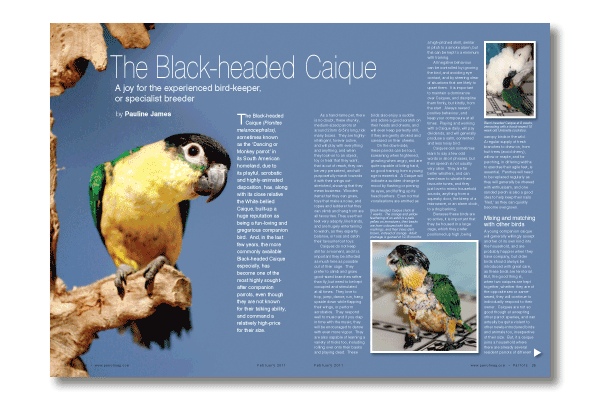
A joy for the experienced bird-keeper, or specialist breeder
by Pauline James
The Black-headed Caique (Pionites melanocephalus), sometimes known as the ‘Dancing or Monkey parrot’ in its South American homeland, due to its playful, acrobatic and highly-animated disposition, has, along with its close relative the White-bellied Caique, built-up a huge reputation as being a fun-loving and gregarious companion bird. And, in the last few years, the more commonly available Black-headed Caique especially, has become one of the most highly sought-after companion parrots, even though they are not known for their talking ability, and command a relatively high-price for their size.
As a hand-tame pet, there is no doubt, these chunky, medium-sized parrots at around 23cm (9.5in) long, tick many boxes. They are highly-intelligent, forever active, and will play with everything and anything, and when they lock-on to an object, toy or treat that they want, that is out of reach, they can be very persistent, and will purposefully march towards it with their wings out-stretched, showing that they mean business. Wooden items that they can gnaw, toys that make a noise, and ropes and ladders that they can climb and hang from are all favourites. They use their feet very adeptly, like hands, and are hugely entertaining to watch, as they expertly balance, or toss and catch their favourite foot toys.
Caiques do not keep still for a moment, and it is important they be afforded as much time as possible out of their cage. They prefer to climb and gnaw good-sized branches rather than fly, but need to be kept occupied and stimulated at all times. They love to hop, jump, dance, run, hang upside down while flapping their wings, or perform acrobatics. They respond well to music and if you clap in time with the music, they will be encouraged to dance with even more vigour. They are also capable of learning a variety of tricks too, including rolling over onto their backs and playing dead. These birds also enjoy a cuddle and adore a good scratch on their heads and chests, and will even keep perfectly still, if they are gently stroked and caressed on their cheeks.
Read more in the magazine…
Buy a copy now!
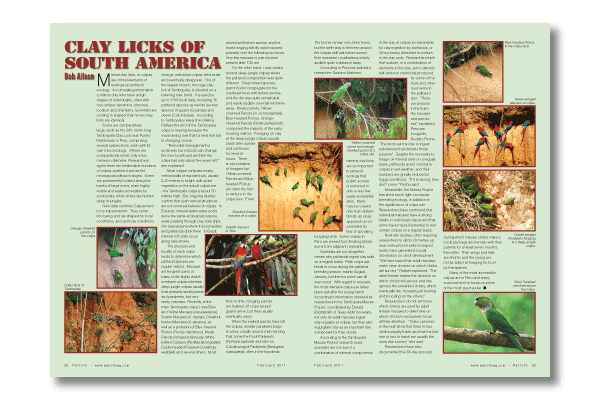
Mineral clay licks, or colpas, are critical elements of neotropical psittacid ecology. Accumulating information confirms clay licks have a high degree of individuality, often with very unique dynamics, structure, location and chemistry. Scientists are coming to suspect that no two clay licks are identical.
Some are comparatively large, such as the 300-metre long Tambopata Clay Lick near Puerto Maldonado in Peru, comprising several subsections, each with its own microecology. Others are comparatively small, only a few metres in diameter. Researchers agree there are inestimable numbers of colpas scattered across the neotropical psittacid ranges. Some are prominently located along the banks of large rivers, main highly visible and easily accessible by ecotourists, while others are hidden deep in jungles.
Read more in the magazine…
Buy a copy now!






